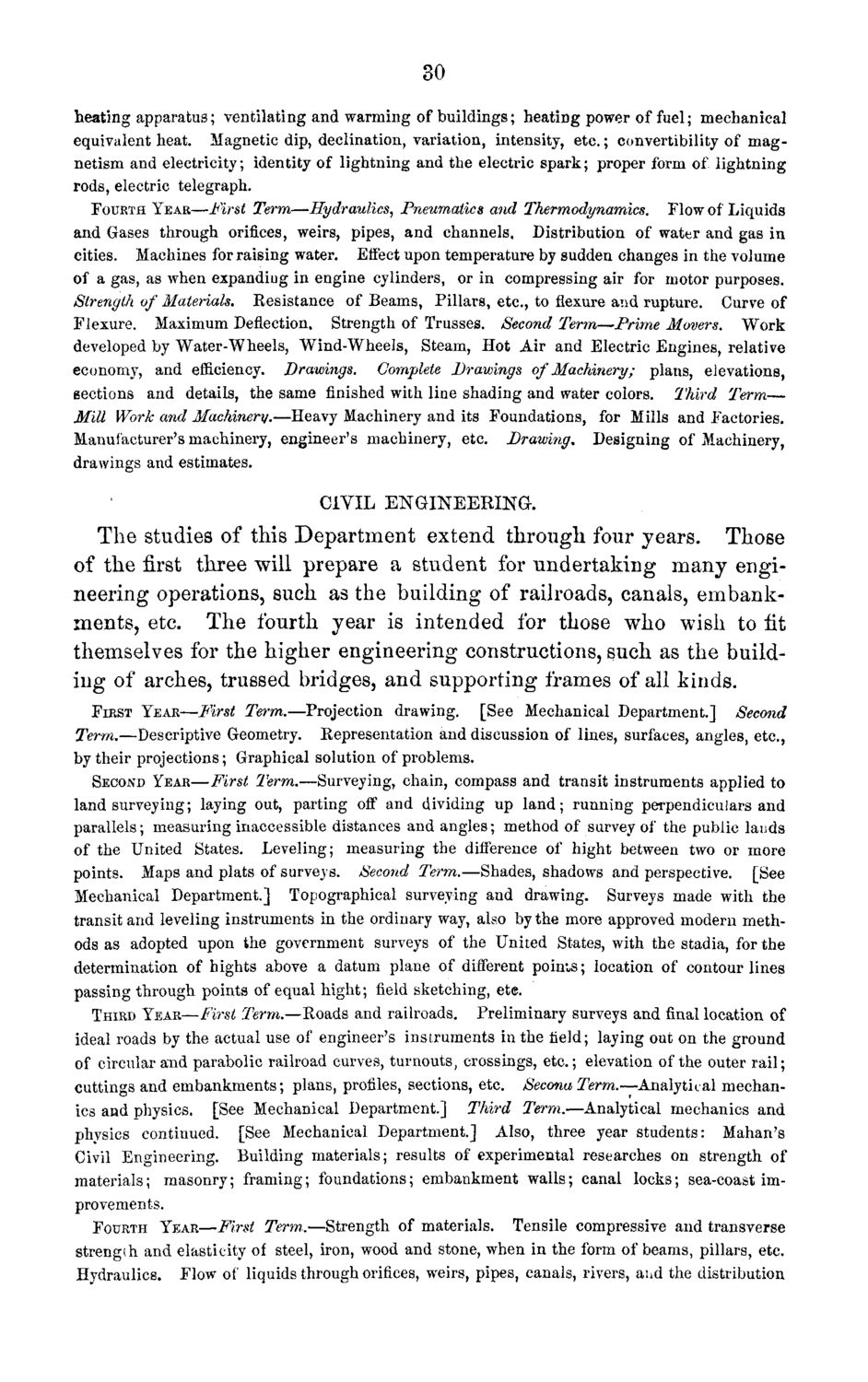| |
| |
Caption: Board of Trustees Minutes - 1871
This is a reduced-resolution page image for fast online browsing.

EXTRACTED TEXT FROM PAGE:
30 heating apparatus; ventilating and warming of buildings; heating power of fuel; mechanical equivalent heat. Magnetic dip, declination, variation, intensity, etc.; convertibility of magnetism and electricity; identity of lightning and the electric spark; proper form of lightning rods, electric telegraph. FOURTH YEAR—First Term—Hydraulics, Pneumatics and Thermodynamics. Flow of Liquids and Gases through orifices, weirs, pipes, and channels. Distribution of water and gas in cities. Machines for raising water. Effect upon temperature by sudden changes in the volume of a gas, as when expandiug in engine cylinders, or in compressing air for motor purposes. Strength of Materials. Resistance of Beams, Pillars, etc., to flexure and rupture. Curve of Flexure. Maximum Deflection. Strength of Trusses. Second Term—Prime Movers. Work developed by Water-Wheels, Wind-Wheels, Steam, Hot Air and Electric Engines, relative economy, and efficiency. Drawings. Complete Drawings of Machinery; plans, elevations, sections and details, the same finished with line shading and water colors. Third Term— Mill Work and Machinery.—-Heavy Machinery and its Foundations, for Mills and Factories. Manufacturer's machinery, engineer's machinery, etc. Drawing, Designing of Machinery, drawings and estimates. CIVIL E N G I N E E R I N G . The studies of this Department extend through four years. Those of the first three will prepare a student for undertaking many engineering operations, such as the building of railroads, canals, embankments, etc. The fourth year is intended for those who wish to lit themselves for the higher engineering constructions, such as the building of arches, trussed bridges, and supporting frames of all kinds. FIRST YEAR—First Term.—Projection drawing. [See Mechanical Department.] Second Term.—Descriptive Geometry. Representation and discussion of lines, surfaces, angles, etc., by their projections; Graphical solution of problems. SECOND YEAR—First Term.—Surveying, chain, compass and transit instruments applied to land surveying; laying out, parting off and dividing up land; running perpendiculars and parallels; measuring inaccessible distances and angles; method of survey of the public lauds of the United States. Leveling; measuring the difference of hight between two or more points. Maps and plats of surveys. Second Term.—Shades, shadows and perspective. [See Mechanical Department.] Topographical surveying and drawing. Surveys made with the transit and leveling instruments in the ordinary way, also by the more approved modern methods as adopted upon the government surveys of the United States, with the stadia, for the determination of hights above a datum plane of different poinis; location of contour lines passing through points of equal hight; field sketching, ete. THIRD YEAR—First Term.—Roads and railroads. Preliminary surveys and final location of ideal roads by the actual use of engineer's instruments in the field; laying out on the ground of circular and parabolic railroad curves, turnouts, crossings, etc.; elevation of the outer rail; cuttings and embankments; plans, profiles, sections, etc. SeconaTerm.—Analytical mechanics and physics. [See Mechanical Department.] Third Term.—Analytical mechanics and physics continued. [See Mechanical Department.] Also, three year students: Mahan's Civil Engineering. Building materials; results of experimental researches on strength of materials; masonry; framing; foundations; embankment walls; canal locks; sea-coast improvements. FOURTH YEAR—First Term.—Strength of materials. Tensile compressive and transverse strength and elasticity of steel, iron, wood and stone, when in the form of beams, pillars, etc. Hydraulics. Flow of liquids through orifices, weirs, pipes, canals, rivers, and the distribution
| |